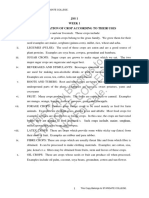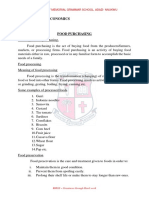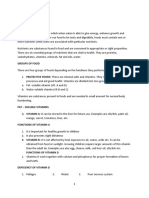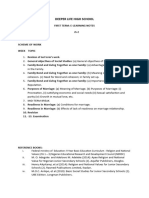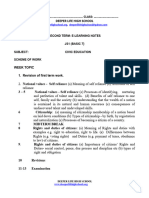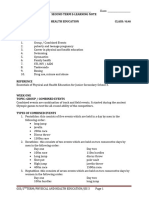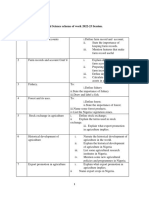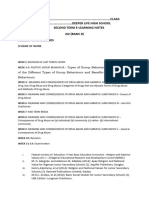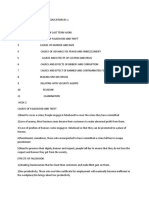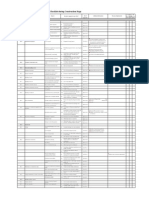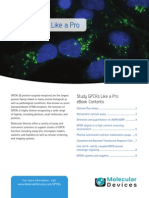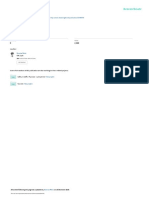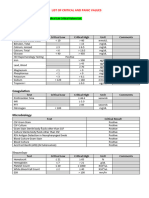Subject: Home Economics Term: Third Class: Jss 3: Bubendorff Memorial Grammar School, Adazi-Nnukwu
Uploaded by
Baba SoskySubject: Home Economics Term: Third Class: Jss 3: Bubendorff Memorial Grammar School, Adazi-Nnukwu
Uploaded by
Baba SoskyBUBENDORFF MEMORIAL GRAMMAR SCHOOL, ADAZI- NNUKWU
SUBJECT: HOME ECONOMICS
TERM: THIRD
CLASS: JSS 3
CHILD DEVELOPMENT
Meaning of growth and development
Growth: Growth is an increase in the physical size of the whole body or any of
its part. A child grows in size, height and weight. Growth is measured in metres
and kilograms.
Development: Development is an increase in skill and complexity of function. A
child is developing when he/she is making progress in what he/she does with
his/her mind and body, such as holding up the head, holding a toy, gaining
understanding, etc.
Principles of development.
1. Development follows a definite pattern.
2. Children develop at different rates. Some may be fast while some other are
slow.
3. Development starts from the head and spreads all over the body. A child
first gains control of the eye, then the head, followed by the arms, trunks
and legs.
4. Development in children is predictable.
5. Development should be steady.
6. It is progressive and orderly in a normal child.
7. Children differ from each other.
Stages of child development.
1. Pre-natal stage: That is, before birth.
2. Infancy: this is the period between birth and one or two years (0-2years).
3. Childhood stage: This is divided into early childhood and late childhood.
4. Puberty and adolescence.
Factors that influence child development
There are two major factors that influence child development.
1. Heredity
2. Environment
BMGS – Greatness through Hard work
BUBENDORFF MEMORIAL GRAMMAR SCHOOL, ADAZI- NNUKWU
Heredity: This refers to the transfer of traits or characteristics from parents to
children through the genes. A trait is any quality that a child inherits from either
of the parents. Physical traits e.g. height, fatness, colour of the skin, eyes, nose,
etc. mental characteristics like talents, intelligence, aggression, etc.
Environment: This includes everything that is outside the child. E.g. love, and
care he/she receives, the family, feeding, clothing, shelter, etc.
Areas of development
There are five areas of development in children;
1. Physical development: This includes physical structures e.g. the brain,
muscles, bones, nerves and their functions.
2. Mental development: This is the development of intellectual abilities. It
involves the ability to think, understand and solve problems.
3. Social development: It begins at birth. Social development includes the
development of behaviours approved by the society. Children need to be
given attention early in life.
4. Emotional development: This involves feelings and how a person
expresses such feelings, for example by smiling, crying, frowning, etc.
5. Moral development: This development shows in behaviour and how
children treat others. The child at certain stage begins to hold opinion
concerning what is right or wrong. Knowing what he should do or not do,
he begins to develop conscience and sense of guilt.
Factors that influence child development or conditions necessary for child
development
1. Love and care from family.
2. Good nutrition/feeding: Children need plenty of nutritious foods to help
them grow develop strong, healthy bodies. This is achieved through
balanced meals.
3. Clothing: they need clothing that is suitable for different weather
conditions.
4. Exercise: They need plenty of exercises to help them to develop strong
bones, muscles and motor skills.
5. Rest: they need plenty of rest and sleep. Good sleep habit promotes
good health.
6. Medical care
7. A safe conducive environment e g. home surroundings for play.
BMGS – Greatness through Hard work
BUBENDORFF MEMORIAL GRAMMAR SCHOOL, ADAZI- NNUKWU
CARE OF THE CHILD e.g. feeding, clothing and bathing.
Feeding the baby: The baby needs good food that promote growth and
development. Poor feeding in infancy can retard growth.
Types of feeding
There are two types of feeding
1. Breast feeding (natural feeding)
2. Bottle feeding/artificial feeding.
Breast feeding or natural feeding: The baby is fed with breast milk.
Exclusive breast feeding: The baby is fed only on breast milk from birth to six
months. No water is given, no solid food at all.
Advantages of breast feeding
1. Breast milk is a complete food for a new born baby. It contains all the food
nutrients.
2. Breast milk contains antibodies. This protects the child from diseases.
3. It is sterile and free from germs.
4. It is easily digested by the baby.
5. Breast feeding brings mother and child very close. It makes the body
happy.
6. It does not require any preparation.
7. It is produced at the right temperature.
8. Breast milk digests easily and it is easily absorbed by the baby.
9. Breast fed babies are not easily constipated.
10.Breast feeding helps mothers to protect themselves against another
pregnancy.
Colostrums: Colostrums is the first milk produced in the first few days by the
nursing or lactating mother. Colostrums is yellowish in colour. It is very rich in
antibodies. Colostrums helps to clear the first sticky stool of the baby called
meconium.
Bottle feeding/artificial feeding: This is the process of feeding the baby with
artificial milk using feeding bottle.
BMGS – Greatness through Hard work
BUBENDORFF MEMORIAL GRAMMAR SCHOOL, ADAZI- NNUKWU
The necessity of bottle feeding
(The need of bottle feeding)
1. Multiple births: E.g. twins, triplets, etc. the mother’s milk may not
be sufficient for the babies.
2. When the mother is working full-time outside the home e.g. a
banker.
3. The mother is sick and cannot breast feed.
4. When the mother cannot produce enough milk.
Disadvantages of bottle feeding
Artificial milk e.g. S.M.A. (cow milk)
1. It is expensive.
2. It does not contain antibodies.
3. Milk can be contaminated by germs during preparation.
4. Constipation is common in bottle-fed babies.
5. It does not bind mother and child together as breast milk does.
6. It wastes time as it requires elaborate preparation.
Weaning the baby
Weaning is the process of gradually introducing the baby to foods other
than milk. Weaning foods are given to baby after four to six months and for the
rest of the first year. Gradually the infant is introduced to wider suitable foods.
Suitable weaning foods: Cereals foods e.g. akamu, cerelac, agidi, etc.
other foods are moi moi, boiled egg, meat, sweet oranges, ripe bananas,
vegetables etc.
Clothing the baby
The baby should be dressed according to the weather. Warm clothes for
cold weather and during harmattan period.
Baby’s layette: Layette is the complete set of cloths required by a new born
baby.
Suggested layette for a baby
1. Napkins/diapers
2. Plastic pants/tie pants
3. Vests
4. Bibs
5. Shawl
BMGS – Greatness through Hard work
BUBENDORFF MEMORIAL GRAMMAR SCHOOL, ADAZI- NNUKWU
6. Dresses
7. Night gowns
8. Sweaters
9. Stockings and bootees
10.Bonnet/hat or cap
Common childhood ailments e.g. colic, constipation, diarrhoea, etc
Children are usually afflicted by certain ailment. They include the following:
1. Infant colic: This is a severe pain in the abdomen caused by intestinal gas
or obstruction in the intestine. The baby cries because of the pain.
2. Constipation: Constipation manifests in the form of passing of hard stool
at long intervals. The baby may pass stool once every two days.
3. Diarrhoea: Loose and watery stool is passed by the baby frequently.
Passing frequent stools can lead to dehydration. Treatment of diarrhoea
involves oral rehydration therapy (O.R.T).
One level teaspoonful of salt, ten level teaspoonful of sugar, half litre of
boiled water (one beer bottle), mix them well in a clean bowl. This is given in
spoonfuls after each stooling. The above mixture in the bowl lasts for 24 hours
(one day). If the mixture remains after one day, throw it away and make another
one. If the condition persists, see a doctor.
4. Convulsion
5. Nappy rash: Continuous use or wearing of napkins/diapers leaves severe
rashes on the child’s skin (buttocks).
IMMUNIZATION FOR CHILDREN
Immunization is the process of protecting a person against diseases by
injecting vaccines into the body. The body is made to acquire immunity in the
process.
Children are immunized against the following diseases
1. Diphtheria
2. Tetanus
3. Whooping cough
4. Polio
5. Measles
BMGS – Greatness through Hard work
BUBENDORFF MEMORIAL GRAMMAR SCHOOL, ADAZI- NNUKWU
6. Tuberculosis
7. Small pox
8. Yellow fever etc
Types of vaccines
1. B.C.G: It is the vaccine given to a new born baby at birth. From 0-
30 days or 0-1 month. B.C.G. protects the baby against tuberculosis.
2. Triple vaccine: this is abbreviated D.P.T. it is a mixture of three
vaccines. The tetanus, whooping cough and diphtheria. It is given by
injection against three diseases.
3. Polio vaccine: this is for protection against poliomyelitis. It is given
orally.
4. Small pox vaccine
5. Quadruple vaccine: for protection against four diseases namely
tetanus, diphtheria, whooping cough and polio.
6. Measles vaccine: it is given to children at the age of 9 months. It
protects them against measles.
CONSUMER CHALLENGES AND RIGHTS
Definition of consumer
A consumer is a person or group of people such as a house hold or an
organisation who purchases goods and services for personal use. A consumer is
a person who makes use of goods and services to satisfy personal or household
needs.
Rights of the consumer
The United Nations set aside 15th of March every year as the world
consumer right day. The consumer has the following rights:
1. Right to safety.
2. Right to be informed
3. The right to choose what he/she wants.
4. The right to be heard
5. The right to satisfaction of basic needs.
6. The right to redress: that is, right of consumer to receive a fair
settlement of just claim. E.g. compensation for misrepresentation.
7. Right to a healthy environment.
BMGS – Greatness through Hard work
BUBENDORFF MEMORIAL GRAMMAR SCHOOL, ADAZI- NNUKWU
Challenges or problems of the consumer
Challenges or problems of the consumer include:
1. Lack of information about some of the goods and services available for
consumption.
2. Hazard of wholesome, unsafe and poor quality products.
3. Activities of business men or traders who sell unsafe or subtended goods
and services.
4. Dealers association who practice monopoly and intimidate consumers.
5. Influence of massive advertisement of goods services.
6. Too many brands of the same goods and services in the markets. The
consumer is faced with the problem of choosing from many goods and
services.
7. The laws that are supposed to protect the consumers are often not
effectively enforced.
8. Many consumers lack consumer education (knowledge, skills , and
attitudes needed to consume intelligently).
Redress options for consumers
Meaning of redress: Redress means the opportunity to seek solutions to a
problem if a consumer has problem with a product or good already purchased.
For instance, if a person buys a fan, or radio or any other goods, and goes home
to discover that it has a fault and does not work, going back to the dealer to
complain and ask for a replacement, is seeking for redress. The following options
may be available to a customer/consumer.
1. Full refund: if the goods are not doing what they are supposed to do, the
consumer is entitled to refund of the cost of the goods if he/she acted
promptly or immediately he discovered the fault and goes to complain.
2. Replacement: the faulty item maybe replaced with a functional one.
3. Adjustment or repair: when the goods are found to have faults, or defects
that can be put right, there could be repair of other items at the sellers
expense.
4. Partial refund: the customer maybe entitled to partial refund of the money
when the complaints are made late.
5. Compensation: this option is adopted if the customer has suffered material
or financial loses because of the faults in the products. The amount of
compensation maybe more than the cost of the goods involved.
BMGS – Greatness through Hard work
BUBENDORFF MEMORIAL GRAMMAR SCHOOL, ADAZI- NNUKWU
Procedure for seeking redress
The following are steps open to consumer whose rights are seriously challenged.
1. Awareness: the existing redress options have to be brought to the
knowledge of consumer.
2. Inspections of goods before purchase to detect faults or defects in
good time.
3. Timely reporting of detected faults or defects.
4. Alternative dispute resolution: it requires a neutral third party such
as consumer association and right activists.
5. Litigation: litigation is the process of making a claim in a court of
law. The consumer can go to court of law to seek redress.
BMGS – Greatness through Hard work
You might also like
- Navman: Installation and Operation ManualNo ratings yetNavman: Installation and Operation Manual18 pages
- JSS2 Agricultural Science Scheme of Work - syllabusNGNo ratings yetJSS2 Agricultural Science Scheme of Work - syllabusNG13 pages
- Subject: Home Economics Term: Third Class: Jss 2 Food PurchasingNo ratings yetSubject: Home Economics Term: Third Class: Jss 2 Food Purchasing3 pages
- Week 1 Lesson Note On (Symptoms Effects and Prevention of Animal Pest and Diseases) Jss 2 Second Term 2023-24 SessionNo ratings yetWeek 1 Lesson Note On (Symptoms Effects and Prevention of Animal Pest and Diseases) Jss 2 Second Term 2023-24 Session9 pages
- Basic 8 Social Studies 1st Term E-Note, 2017No ratings yetBasic 8 Social Studies 1st Term E-Note, 201714 pages
- JSS 1 Religious Education First Term NoteNo ratings yetJSS 1 Religious Education First Term Note9 pages
- Revised Basic 7 Social Studies Second Term 2017100% (1)Revised Basic 7 Social Studies Second Term 201717 pages
- NEW JS1 CIVIC EDUC 2ND TERM E-NOTES - Docx REVIEWEDNo ratings yetNEW JS1 CIVIC EDUC 2ND TERM E-NOTES - Docx REVIEWED24 pages
- Lesson Note on Business Studies JSS 3 Second Term - Edudelight.cNo ratings yetLesson Note on Business Studies JSS 3 Second Term - Edudelight.c46 pages
- SS2 Agricultural Science First Term Note, 2023-2024No ratings yetSS2 Agricultural Science First Term Note, 2023-202442 pages
- Subject: Social Studies Term: Third Class: Jss 3 Week 2 Common Crimes and Associated PunishmentNo ratings yetSubject: Social Studies Term: Third Class: Jss 3 Week 2 Common Crimes and Associated Punishment2 pages
- 2023 AGRIC. SCIENCE JS 2 2ND TERM E-Note Template100% (1)2023 AGRIC. SCIENCE JS 2 2ND TERM E-Note Template45 pages
- 2022-23 Js3 Agric SC Updated Students Printed NoteNo ratings yet2022-23 Js3 Agric SC Updated Students Printed Note22 pages
- Basic 8 Social Studies 2ND Term E-Note 2017No ratings yetBasic 8 Social Studies 2ND Term E-Note 201719 pages
- Jss 2 Basic Science Second Term PPT - 2No ratings yetJss 2 Basic Science Second Term PPT - 275 pages
- 47-Child-Development-and-Care1736532844No ratings yet47-Child-Development-and-Care173653284411 pages
- 3 - q4 Electronics Special Science ClassNo ratings yet3 - q4 Electronics Special Science Class25 pages
- Check List - 2B: Environmental Audit Checklist During Construction StageNo ratings yetCheck List - 2B: Environmental Audit Checklist During Construction Stage2 pages
- The Minhag of Eating Dairy Products On ShavuotNo ratings yetThe Minhag of Eating Dairy Products On Shavuot3 pages
- Instant Download Are You an Inclusive Designer 1st Edition Julie Fleck PDF All Chapters100% (1)Instant Download Are You an Inclusive Designer 1st Edition Julie Fleck PDF All Chapters67 pages
- Dokumen - Tips - 1 CNG Dealer Training 2 What Is CNG CNG Is Natural Gas Compressed To A Pressure of 200 250 KGCM G Why CNG Is Used in Vehicles Instead of NaturalNo ratings yetDokumen - Tips - 1 CNG Dealer Training 2 What Is CNG CNG Is Natural Gas Compressed To A Pressure of 200 250 KGCM G Why CNG Is Used in Vehicles Instead of Natural39 pages
- Lesson 4 Lecture Planning and Programming in The Multigrade Classroom1No ratings yetLesson 4 Lecture Planning and Programming in The Multigrade Classroom113 pages
- Gender Toolkit: A Manual For Youth Peace Workers100% (1)Gender Toolkit: A Manual For Youth Peace Workers71 pages
- A - Detailed - Lesson - Plan - in - Science - Grade - Rayge Final DemoNo ratings yetA - Detailed - Lesson - Plan - in - Science - Grade - Rayge Final Demo8 pages


